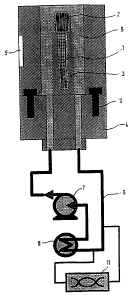Une partie des informations de ce site Web a été fournie par des sources externes. Le gouvernement du Canada n'assume aucune responsabilité concernant la précision, l'actualité ou la fiabilité des informations fournies par les sources externes. Les utilisateurs qui désirent employer cette information devraient consulter directement la source des informations. Le contenu fourni par les sources externes n'est pas assujetti aux exigences sur les langues officielles, la protection des renseignements personnels et l'accessibilité.
L'apparition de différences dans le texte et l'image des Revendications et de l'Abrégé dépend du moment auquel le document est publié. Les textes des Revendications et de l'Abrégé sont affichés :
| (12) Brevet: | (11) CA 2331211 |
|---|---|
| (54) Titre français: | PROCEDE DE PRODUCTION D'ACTINIUM-225 PAR IRRADIATION DE RADIUM-226 AU MOYEN DE PROTONS |
| (54) Titre anglais: | METHOD FOR PRODUCING AC-225 BY IRRADIATION OF RA-226 WITH PROTONS |
| Statut: | Réputé périmé |
| (51) Classification internationale des brevets (CIB): |
|
|---|---|
| (72) Inventeurs : |
|
| (73) Titulaires : |
|
| (71) Demandeurs : |
|
| (74) Agent: | ROBIC |
| (74) Co-agent: | |
| (45) Délivré: | 2008-09-23 |
| (86) Date de dépôt PCT: | 1999-05-26 |
| (87) Mise à la disponibilité du public: | 1999-12-09 |
| Requête d'examen: | 2003-12-17 |
| Licence disponible: | S.O. |
| (25) Langue des documents déposés: | Anglais |
| Traité de coopération en matière de brevets (PCT): | Oui |
|---|---|
| (86) Numéro de la demande PCT: | PCT/EP1999/003651 |
| (87) Numéro de publication internationale PCT: | WO1999/063550 |
| (85) Entrée nationale: | 2000-11-02 |
| (30) Données de priorité de la demande: | ||||||
|---|---|---|---|---|---|---|
|
Cette invention a trait à un procédé de production d'actinium-225 consistant à préparer une cible contenant du radium-226, à irradier cette cible au moyen de protons dans un cyclotron et à séparer par voie chimique l'actinium du matériau constituant la cible irradiée. On adapte, dans le cadre de cette invention, l'énergie des protons dans le cyclotron, de manière que l'énergie incidente au Ra-226 soit comprise entre 10 et 20 MeV, de préférence entre 14 et 17 MeV. On arrive, de ce fait, à accroître la production de l'isotope désiré, Ac-225, en comparaison de celle des autres radio-isotopes.
This invention refers to a method for producing Actinium-225, comprising the
steps
of preparing a target (1) containing Radium-226, of irradiating this target
with protons
in a cyclotron and of chemically separating Actinium from the irradiated
target material
thereafter. According to the invention the proton energy in the cyclotron is
adjusted such
that the energy incident on the Ra-226 is between 10 and 20 MeV, preferably
between
14 and 17 MeV. By this means the yield of production of the desired isotope Ac-
225 is
enhanced with respect to other radioisotopes.
Note : Les revendications sont présentées dans la langue officielle dans laquelle elles ont été soumises.
Note : Les descriptions sont présentées dans la langue officielle dans laquelle elles ont été soumises.

Pour une meilleure compréhension de l'état de la demande ou brevet qui figure sur cette page, la rubrique Mise en garde , et les descriptions de Brevet , États administratifs , Taxes périodiques et Historique des paiements devraient être consultées.
| Titre | Date |
|---|---|
| Date de délivrance prévu | 2008-09-23 |
| (86) Date de dépôt PCT | 1999-05-26 |
| (87) Date de publication PCT | 1999-12-09 |
| (85) Entrée nationale | 2000-11-02 |
| Requête d'examen | 2003-12-17 |
| (45) Délivré | 2008-09-23 |
| Réputé périmé | 2017-05-26 |
Il n'y a pas d'historique d'abandonnement
Les titulaires actuels et antérieures au dossier sont affichés en ordre alphabétique.
| Titulaires actuels au dossier |
|---|
| EUROPEAN COMMUNITY (EC) |
| Titulaires antérieures au dossier |
|---|
| APOSTOLIDIS, CHRISTOS |
| JANSSENS, WILLEM |
| KOCH, LOTHAR |
| MCGINLEY, JOHN |
| MOLINET, ROGER |
| MOLLENBECK, JOSEF |
| OUGIER, MICHEL |
| SCHWEICKERT, HERMANN |
| VAN GEEL, JACQUES |